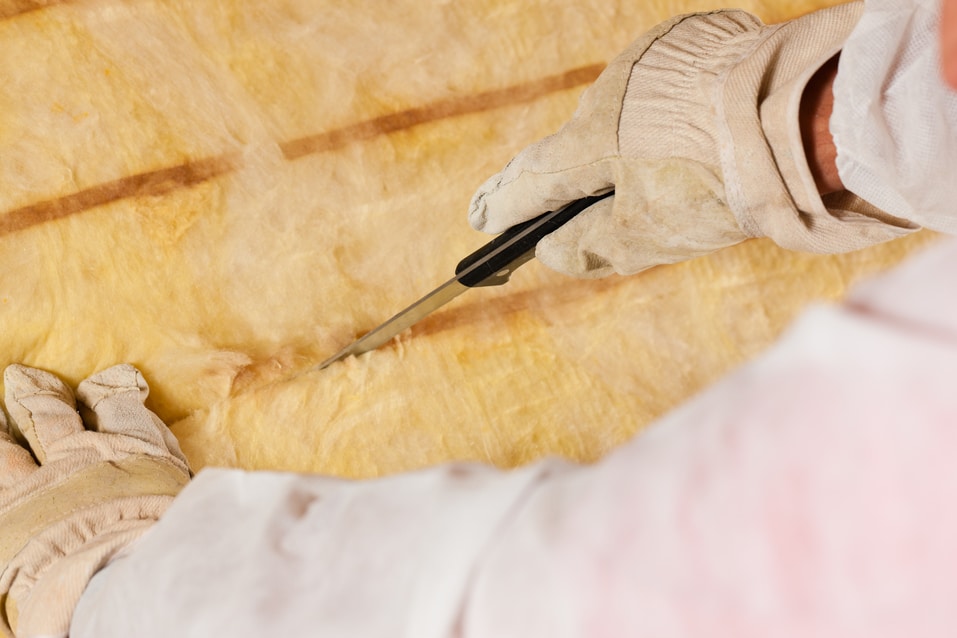Fiberglass is a thin, synthetic material made of glass fibers. It is common in insulation and many household appliances. However, if exposed to fiberglass insulation, the fibers can cut the skin and cause irritation and other issues. Therefore, it’s essential to know how to remove fiberglass insulation from your skin to prevent long-term risks.
Understanding the risks of fiberglass exposure is crucial when working with it or facing long-term exposure. Keep reading if you’re curious how to get fiberglass out of your skin, from under your skin, or stop a fiberglass rash.
Risks Associated with Fiberglass Exposure
While fiberglass has no severe side effects, there are some risks to exposure as it can travel from your skin to other parts of the body very quickly. Skin irritation and respiratory issues are common. There is no known link to cancer, but you may need medical assistance.
Skin Irritation
Fiberglass in the skin causes microscopic cuts and may get trapped. Common symptoms are skin irritation, such as a rash, which can also cause skin peeling and blisters. Itchy, rash skin occurs due to direct fiberglass exposure, so wearing the proper protective gear is essential when handling fiberglass insulation.
Other Complications
Further exposure to fiberglass insulation can cause respiratory issues and related complications. Regular exposure may cause more frequent coughing, sneezing, itching, and worsened asthma symptoms.
Coughing
Breathing in fiberglass insulation is easy; you may feel fiberglass particles trapped in your throat. Breathing struggles, coughing, and wheezing are common signs that fiberglass may be in your lungs.
Sneezing
Sneezing is another respiratory symptom of exposure to fiberglass. Small amounts of fiberglass dust can get into your nose, blocking the airways and tearing the tissue inside, causing breathing difficulties and nosebleeds.
Itching
When you have fiberglass irritation, skin and respiratory tract itchiness may occur. Breathing in fiberglass particles can cause internal irritation, while direct skin contact with insulation can also cause itching. Removing fiberglass insulation from your skin after exposure can help you decrease itchiness.
Worsened Asthma Symptoms
In individuals with a history of bronchitis or asthma, these conditions may worsen with fiberglass insulation exposure. Increased asthma symptoms may warrant a trip to your medical professional.

Long-Term Exposure Effects
Prolonged exposure can lead to respiratory issues and potential lung damage. While there is no conclusive link to cancer, the International Agency for Research on Cancer (IARC) classifies certain types of fiberglass as possibly carcinogenic to humans (CDC) (Materials Market).
Respiratory Issues
Chronic exposure to airborne fiberglass particles can lead to respiratory problems, such as persistent coughing and wheezing, and potentially more severe conditions like chronic bronchitis. Protective gear, such as masks and respirators, is crucial to minimize inhalation risks (CDC) (Materials Market).
Skin Irritation
Repeated contact with fiberglass can cause chronic skin irritation. Individuals with prolonged exposure may experience persistent itching, rashes, and in severe cases, dermatitis. Protective clothing and immediate washing after contact are essential preventive measures (Washington State Department of Health) (Materials Market).
Potential Carcinogenic Effects
The International Agency for Research on Cancer (IARC) classifies certain types of fiberglass as possibly carcinogenic to humans, although the evidence is not conclusive. Continued research is essential, and it is advisable to strictly minimize exposure and follow safety guidelines (CDC) (Materials Market).
How to Remove Fiberglass from Your Skin

If you notice irritation after exposure to fiberglass, get fiberglass out of your skin immediately to prevent further damage. Some fibers will eventually come out of the skin by themselves. Follow these steps if you don’t know how to get fiberglass insulation out of your skin or need help getting insulation off your skin.
- Examine the Affected Area: Carefully examine the skin to identify where the fiberglass fibers have settled. This will help you focus your cleaning efforts more effectively.
- Gather Supplies: Make sure you have mild soap, a washcloth, duct tape, and a clean towel. A magnifying glass is also helpful for seeing smaller fibers.
- Rinse with Lukewarm Water: Gently rinse the affected area with lukewarm water. Avoid hot water as it can open pores, allowing fibers to penetrate deeper into the skin.
- Use Soap and Washcloth: Apply mild soap to the area and gently scrub the skin with a soft washcloth. This will help remove any loose fibers.
- Apply Duct Tape: Cut a piece of duct tape and gently press it onto the affected area. Carefully lift the tape off to remove embedded fibers. Repeat as necessary with new pieces of tape until the fibers are gone.
- Shower Thoroughly: Take a warm (not hot) shower to wash off any remaining fiberglass particles. Use plenty of soap and water.
- Soothing the Skin: After drying off, apply an anti-itch lotion or hydrocortisone cream to soothe any irritation. Natural remedies like aloe vera can also provide relief.
After thoroughly cleaning your clothes, body, and appliances that have come in contact with fiberglass, your fiberglass irritation symptoms should disappear. If your fiberglass itch lasts even after removing visible fibers from your skin or you have respiratory symptoms, visit your doctor.
Helpful Reading: How Long Does Insulation Last
Lessen Your Chances of Exposure to Fiberglass
Along with knowing how to get fiberglass insulation out of your skin, lessening your exposure is instrumental in preventing the damaging effects of insulation. When facing fiberglass exposure at work, you can implement the following practices:
- Wear loose-fitting clothes, protective goggles, gloves, masks, and closed shoes.
- Wash clothes that are worn around fiberglass immediately and clean your washing machine.
- Open doors and windows to increase airflow.
- Remove fiberglass dust with water and a filtered vacuum.
- Before eating and drinking, wash your hands and avoid exposing foods to fiberglass insulation.
- A shop vacuum with an HEPA filter is used to clean up fiberglass debris, effectively capturing glass fibers and reducing exposure (Washington State Department of Health).
Long-Term Solutions
Upgrading Insulation
Modern alternatives to fiberglass, such as cellulose or spray foam insulation, are less irritating and perform similarly or better.
Hire professional insulation installers who can handle these materials safely and effectively.
Home Maintenance
Conduct regular inspections of your home’s insulation. Look for signs of damage or wear and repair any issues promptly to prevent fiberglass fibers from becoming airborne.
If you must handle fiberglass insulation in a contained environment to prevent fibers from spreading.
Professional Services
For large insulation projects or repairs, hire professionals trained in safely handling and removing fiberglass insulation. This minimizes your risk of exposure.
Ensure the professionals you hire follow industry standards and use state-of-the-art technology to handle insulation safely.
Frequently Asked Questions (FAQs) – Fiberglass Insulation
In addition to questions like “How long does fiberglass stay in your skin?” and “How do you get fiberglass out of your skin?” many people have concerns regarding illness and injury from fiberglass. Remaining highly informed can help you follow all proper practices regarding fiberglass insulation handling and help prevent unnecessary exposure.
Can Fiberglass in Your Skin Make You Sick?
There are no known links between fiberglass insulation and cancer, lung disease, or other severe respiratory conditions. Fiberglass in the skin can’t make you sick, but it can make your skin itchy, sore, and irritated. Learn how to get rid of fiberglass itch to prevent this inconvenience.
Why does Fiberglass Hurt your Skin?
Fiberglass hurts your skin due to its sharp, thin, yet durable material. When this tiny glass threading comes in contact with your skin, its material causes microscopic abrasions. Removing fiberglass insulation from your skin safely reduces and prevents extended skin irritation after fiberglass exposure.
Call Attic Projects, the Insulation Experts, Today

If you’re still wondering how to get fiberglass out of your skin, look no further than Attic Projects for tips on protecting yourself and avoiding the harmful, painful effects of handling or being exposed to fiberglass insulation. We have years of experience installing, replacing, and maintaining fiberglass insulation in San Diego, CA, and Orange, CA. We’ll guide you on removing insulation from your skin and provide unique insight.
Whether you need additional insulation in your home to maintain indoor temperatures during the winter or you need to remove moldy fiberglass insulation, we have the leading solutions and quality insulative materials. Our attic and crawlspace experts follow industry standards for insulation installation and use state-of-the-art technology. You’ll get an individualized solution for your home.
Don’t let your fear of fiberglass insulation exposure leave you with high energy bills. Our team is dedicated to attention to detail, knowledge, and professionalism. If you want to know more about how to remove fiberglass insulation or schedule service, contact Attic Projects today.




